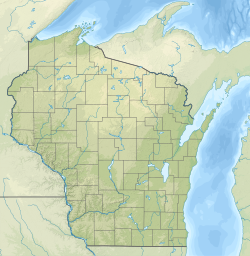| Kilbourn Dam | |
|---|---|
 | |
| Location | Wisconsin Dells, Wisconsin |
| Coordinates | 43°37′36″N89°46′53″W / 43.62672699°N 89.7812986°W |
| Purpose | Power |
| Construction began | December 1906 |
| Opening date | August 1909 |
| Operator(s) | Alliant Energy |
| Dam and spillways | |
| Type of dam | Gravity dam |
| Impounds | Wisconsin River |
| Height | 61 ft (19 m) |
| Length | 560 ft (170 m) [1] |
| Reservoir | |
| Creates | Kilbourn Flowage |
| Total capacity | 36,000 acre⋅ft (0.044 km3) [1] |
| Power Station | |
| Installed capacity | 10MW |
The Kilbourn Dam is a concrete hydroelectric dam on the Wisconsin River at Wisconsin Dells, Wisconsin. It is owned and operated by Alliant Energy. [2]
